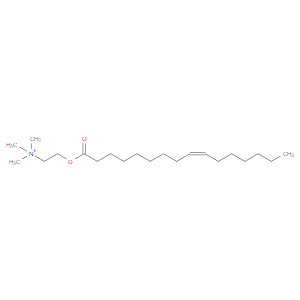|
9-Hexadecenoylcholine, also known as palmitoloelycholine, is a fatty acid-choline and is the ester product of 9-hexadecenoic acid and choline. The pharmacological effects of a series of fatty acid-choline esters have been studied on the isolated rabbit heart, the isolated guinea-pig ileum, and the rat stomach. The effect changed with increasing chain length, and three different types of response were observed. The short-chain compounds produced depression of the isolated rabbit heart and spasm of the isolated guinea-pig ileum. Only one, butyrylcholine, had an erratic stimulating effect on hydrochloric acid secretion by the partially vagotomized rat stomach. Medium-chain compounds had a stimulating effect on the isolated rabbit heart, a mixed spasmogenic and relaxant effect on the isolated guinea-pig ileum, and no effect on the rat stomach. Long-chain compounds blocked the effect of acetylcholine on the isolated rabbit heart and the isolated guinea-pig ileum; they also depressed spontaneous hydrochloric acid secretion by the rat stomach.
|
 click to show the details of this protein
click to show the details of this protein
 click to show the details of experiment for validating this pair
click to show the details of experiment for validating this pair

